Mac notebook and other portable computing is covered in The 'Book Review. iPad, iPod, iPhone, and
Apple TV news is covered in iOS News
Review. All prices are in US dollars unless otherwise noted.
News & Opinion
Software
News & Opinion
Apple Releases OS X Mountain Lion Developer
Preview
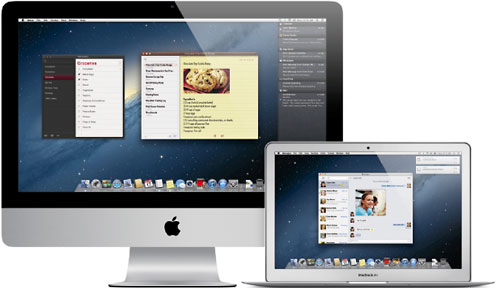
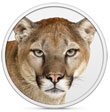 PR: Apple on Thursday released a developer preview of
OS X 10.8 Mountain Lion,
the ninth major release of Apple's 10-series desktop operating
system.
PR: Apple on Thursday released a developer preview of
OS X 10.8 Mountain Lion,
the ninth major release of Apple's 10-series desktop operating
system.
 Mountain Lion
brings popular apps and features from iPad to the Mac and accelerates
the pace of OS X innovation - introducing Messages, Notes, Reminders,
and Game Center to the Mac, as well as Notification Center, Share
Sheets, Twitter integration, and AirPlay Mirroring. Mountain Lion is
the first OS X release built with iCloud in mind for easy setup and
integration with apps.
Mountain Lion
brings popular apps and features from iPad to the Mac and accelerates
the pace of OS X innovation - introducing Messages, Notes, Reminders,
and Game Center to the Mac, as well as Notification Center, Share
Sheets, Twitter integration, and AirPlay Mirroring. Mountain Lion is
the first OS X release built with iCloud in mind for easy setup and
integration with apps.
 The developer preview of Mountain
Lion also introduces Gatekeeper, a new (Apple says "revolutionary")
security feature to helps keep you safe from malicious software by
giving users complete control over what apps are installed on your
Mac.
The developer preview of Mountain
Lion also introduces Gatekeeper, a new (Apple says "revolutionary")
security feature to helps keep you safe from malicious software by
giving users complete control over what apps are installed on your
Mac.
The preview release of Mountain Lion is available to Mac Developer
Program. Apple says Mac users will be able to upgrade to Mountain Lion
from the Mac App Store in late summer 2012.
 "The Mac is on a roll, growing faster
than the PC for 23 straight quarters, and with Mountain Lion things get
even better," commented Philip Schiller, Apple's senior vice president
of Worldwide Marketing. "The developer preview of Mountain Lion comes
just seven months after the incredibly successful release of Lion and
sets a rapid pace of development for the world's most advanced personal
computer operating system."
"The Mac is on a roll, growing faster
than the PC for 23 straight quarters, and with Mountain Lion things get
even better," commented Philip Schiller, Apple's senior vice president
of Worldwide Marketing. "The developer preview of Mountain Lion comes
just seven months after the incredibly successful release of Lion and
sets a rapid pace of development for the world's most advanced personal
computer operating system."
 The developer
preview of Mountain Lion features the all new Messages app, which
replaces iChat and allows you to send unlimited messages, high-quality
photos, and videos directly from your Mac to another Mac or iOS device.
Messages will continue to support AIM, Jabber, Yahoo! Messenger, and
Google Talk. Starting today, Lion users can download a beta of
Messages.
The developer
preview of Mountain Lion features the all new Messages app, which
replaces iChat and allows you to send unlimited messages, high-quality
photos, and videos directly from your Mac to another Mac or iOS device.
Messages will continue to support AIM, Jabber, Yahoo! Messenger, and
Google Talk. Starting today, Lion users can download a beta of
Messages.
 The final version will be available
with Mountain Lion. Reminders and Notes help you create and track your
to-dos across all your devices. Game Center lets you personalize your
Mac gaming experience, find new games, and challenge friends to play
live multiplayer games, whether they're on a Mac, iPhone, iPad, or iPod
touch.
The final version will be available
with Mountain Lion. Reminders and Notes help you create and track your
to-dos across all your devices. Game Center lets you personalize your
Mac gaming experience, find new games, and challenge friends to play
live multiplayer games, whether they're on a Mac, iPhone, iPad, or iPod
touch.

 Mountain Lion presents
notifications in an elegant new way, and Notification Center provides
easy access to alerts from Mail, Calendar, Messages, Reminders, system
updates, and third party apps. Systemwide Share Sheets make it easy to
share links, photos, and videos directly from Apple and third party
apps.
Mountain Lion presents
notifications in an elegant new way, and Notification Center provides
easy access to alerts from Mail, Calendar, Messages, Reminders, system
updates, and third party apps. Systemwide Share Sheets make it easy to
share links, photos, and videos directly from Apple and third party
apps.

 Twitter is
integrated throughout Mountain Lion so you can sign on once and tweet
directly from Safari, Quick Look, Photo Booth, Preview, and third party
apps. Mountain Lion also introduces AirPlay Mirroring, an easy way to
wirelessly send a secure 720p video stream of what's on your Mac to an
HDTV using Apple TV.
Twitter is
integrated throughout Mountain Lion so you can sign on once and tweet
directly from Safari, Quick Look, Photo Booth, Preview, and third party
apps. Mountain Lion also introduces AirPlay Mirroring, an easy way to
wirelessly send a secure 720p video stream of what's on your Mac to an
HDTV using Apple TV.
More than 100 million users have iCloud accounts, and Apple says
Mountain Lion makes it easier than ever to set up iCloud and access
documents across your devices. Mountain Lion uses your Apple ID to
automatically set up Contacts, Mail, Calendar, Messages, FaceTime, and
Find My Mac. The new iCloud Documents pushes any changes to all your
devices so documents are always up to date, and a new API helps
developers make document-based apps work with iCloud.
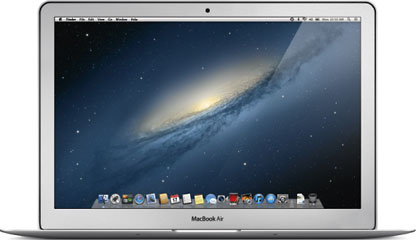 The
new Gatekeeper security feature gives you control over which apps can
be downloaded and installed on your Mac. You can choose to install apps
from any source, just as you do on a Mac today, or you can use the
safer default setting to install apps from the Mac App Store, along
with apps from developers that have a unique Developer ID from Apple.
For maximum security, you can set Gatekeeper to only allow apps from
the Mac App Store to be downloaded and installed.
The
new Gatekeeper security feature gives you control over which apps can
be downloaded and installed on your Mac. You can choose to install apps
from any source, just as you do on a Mac today, or you can use the
safer default setting to install apps from the Mac App Store, along
with apps from developers that have a unique Developer ID from Apple.
For maximum security, you can set Gatekeeper to only allow apps from
the Mac App Store to be downloaded and installed.
Mountain Lion also has features specifically designed to support
Chinese users, including significant enhancements to the Chinese input
method and the option to select Baidu search in Safari. Mountain Lion
makes it easy to set up Contacts, Mail, and Calendar with top email
service providers QQ, 126, and 163. Chinese users can also upload video
via Share Sheets directly to leading video websites Youku and Tudou,
and systemwide support for Sina weibo makes microblogging easy.
Hundreds of new APIs give developers access to new core technologies
and enhanced features within OS X. The Game Kit APIs tap into the same
services as Game Center on iOS, making it possible to create
multiplayer games that work across Mac, iPhone, iPad, and iPod touch. A
new graphics infrastructure underpins OpenGL and OpenCL and implements
GLKit, first introduced in iOS 5, to make it easier to create OpenGL
apps. Using Core Animation in Cocoa apps is easier than ever, and new
video APIs deliver modern 64-bit replacements for low-level QuickTime
APIs. Enhanced Multi-Touch APIs give developers double-tap zoom support
and access to the systemwide lookup gesture. Kernel ASLR improves
security through enhanced mitigation against buffer overflow
attacks.
Publisher's note: The new graphics infrastructure means no support
for Macs with Intel GMA 950 or X3100 graphics, and possibly Macs with
other GPUs as well. This includes many 2006 Macs that are compatible
with Lion, as well as some Macs discontinued in Early 2009. For more
details, see Too Many
Macs Left Behind by OS X 10.8 Mountain Lion. dk
Link: OS X 10.8 Mountain
Lion
The Original Macintosh's Designer on Steve
Jobs
Paula Routly of the Vermont-based journal Seven Days has posted a
fascinating interview with Jerry Manock, who back in the day filled the
Jonathan Ive role for then-fledgling Apple, designing the classic
original compact Macintosh, and well as the Apple II, the Apple III and
the Apple disk II.
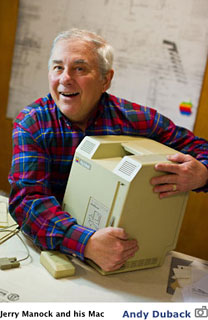 Manock, who these days lives in Burlington,
Vermont, was 33 back in 1977 when he was one of Apple's five employees,
hired by Steve Jobs as a consultant to design the Apple II. Routly
reports that Manock gets credit for almost everything but the circuit
board and the logic (which was engineered by Jobs partner and Apple
cofounder Steve Wozniak), including the structure, the outside
aesthetics, and the color beige (Pantone 453, the color of the
deep-space universe, Manock says), and was part of the original team of
a half-dozen workers who designed the original Mac.
Manock, who these days lives in Burlington,
Vermont, was 33 back in 1977 when he was one of Apple's five employees,
hired by Steve Jobs as a consultant to design the Apple II. Routly
reports that Manock gets credit for almost everything but the circuit
board and the logic (which was engineered by Jobs partner and Apple
cofounder Steve Wozniak), including the structure, the outside
aesthetics, and the color beige (Pantone 453, the color of the
deep-space universe, Manock says), and was part of the original team of
a half-dozen workers who designed the original Mac.
Manock worked under Jobs for three-and-a-half years, a witness to
Apple's early innovation, exponential growth, and subsequent conflicts,
including the legendary one between Jobs and CEO John Sculley.
Manock, now 66, is currently sole proprietor of Manock Comprehensive Design, and for 21
years has taught a University of Vermont class on integrated product
development.
Routly's article provides more insight into the enigmatic Jobs,
Manock relating that he would say things like, "I was just thinking, in
my career I could be the CEO of two or three billion-dollar
companies."
"When somebody asked him what kind of market share he wanted, Steve
was famous for saying, I want it all. I want 100 percent," Manock
recalls.
For all his involvement with computers, Manock is not an uncritical
cheerleader for what they have wrought. He notes, "Nowadays you can
design something in 3D, have photorealistic rendering, cast shadows and
specify, This is metal. This is wood. You can come up with a
picture of it without ever touching a physical thing, without ever
building a model to hold in your hand. To me, that's really
dangerous."
He also says he gets really upset when he's walking downtown and
there are young people walking toward him, all with their heads down.
"I try to make eye contact to say hello, good morning, and nothing. The
disconnect there bothers me, and that's going to get nothing but worse.
I've got my iPhone and GPS and news anytime I want it. But my mindset
is: I'm not married to this thing. I don't have to look at it every
five minutes. I can kind of use the technology for what I need. I feel
pretty balanced that way. And I've made a conscious decision not to go
with all the social-media stuff, because it takes up too much of my
time. I can't read a book. I can't sketch. I can't go to movies if I'm
constantly tweeting somebody."
Link: iWitness
Mac Pro Update Finally on the Way?
M.I.C.Gadget's Steve Lo observes understatedly that it's been a
while, but says he has some very exciting news, ergo: that Apple is
close to finally updating the Mac Pro.
Lo notes that Intel will be moving to its next-generation Ivy Bridge
Core i CPU platform in April, and that this is expected to solve
heating issues in comparison to the current Sandy Bridge processor
family thanks to the extremely efficient 22nm manufacturing process,
replacing old transistor types with tri-gate transistors, which Lo says
are over 30% more efficient in heat dissipation.
Ivy Bridge will be the first chip to use Intel's 22nm tri-gate
transistors, and Lo says M.I.C. Gadget's sources tell him that
engineering samples of the new processors, with 8 cores and a whopping
20 MB of cache, have been given to Apple for testing, that overheating
issues have been eliminated, and that the manufacturing yield is now
high enough for Apple to maintain its high profit margin.
So basically, says Lo, the new Mac Pro will transition from two
high-performing 6-core CPUs to two even higher performing 8-core chips
- but that's not all
Lo notes that Apple went with ATI graphics for its last generation
Mac Pro and got burned, with problems that include flickering,
artifacts, overheating, no display, and more, and that the upgrade
drivers ATI made for the Mac Pro were also notoriously flaky even after
Apple took a crack at updating them, all of which cost Apple a
significant amount of money - something they're not looking to not
repeat.
Which brings us to
Nvidia's Kepler series of graphics cards that are projected for
release in the April/May time frame, which is around the same time as
Intel's Ivy Bridge silicon is expected to be available. Lo says his
sources within the company indicate that Nvidia has been chosen for
graphics.
However, it's not quite time to be holding your breath yet. Lo says
new Mac Pros could appear near the end of Q3 2012, after early
production bugs have been ironed out of the new released hardware and
driver/software issues have been addressed.
Link: Apple Is Close to
Finally Updating the Mac Pro
6% of US Internet Users Still Using Dial-up
The Pittsburgh Post-Gazette's Deborah M. Todd reports that in a
surprising number of households, the sound of dial-up tones still
resonate, noting that 74% of US adults had Internet access in their
homes by 2010, and 6% were still relying solely on dial-up Internet
connections to go online, according to a Federal Communications
Commission report that looked at broadband access.
Notwithstanding the fact that Apple, for instance, appears to regard
dial-up as an artifact of the past - OS X 10.7 Lion no longer supports
Apple's own USB modem that was discontinued in 2009 - the old
connection protocol is not dead by a long shot.
Last year, AOL, added 200,000 new dial-up customers.
Todd notes that just last year, AOL, whose more than 3.5 million
dial-up users account for the bulk of residual dial-up business, added
200,000 new dial-up customers, and even Verizon Communications, which
provides high-speed Internet services via fiber optic FIOS service or
digital subscriber lines (DSL) to the majority of its 8.7 million
subscribers, still also provides dial-up Internet to more than 31,000
US customers.
So why are people stubbornly persisting with dial-up? Ms. Todd says
that according to the FCC report, respondents still using dial-up cited
monthly costs as a primary factor (the FCC report cites average monthly
costs for dial-up Internet at around $22, while the average costs for
broadband service is around $37), followed by satisfaction with current
services, sporadic Internet usage, reservations about entering
long-term contracts, high activation costs, a lack of need for speedier
service, and a lack of availability for high-speed services in their
areas.
Another reason is reliability and easy access. While more and more
households have dropped land line telephone service, most homes still
have it, and dial-up Internet networks are more robust than, for
example, the wireless or satellite high-speed networks that serve many
extra-urban areas, especially in bad weather.
Todd also explores the issue of a deepening and widening digital
divide due to the fact that high-speed Internet service is still simply
unavailable in many rural localities, due to economies of scale making
it unattractive to providers. Government subsidization and possibly
legislation will probably be necessary to make high speed Internet
coverage available to all rural residents.
Link: Plenty of
Internet Users Cling to Slow Dial-up Connections
Tim Cook's Goldman Sachs Technology and Internet
Presentation
Apple has posted an audio webcast of Tim Cook's presentation at the
Goldman Sachs Technology and Internet Conference from February 14, 2012
in which Mr. Cook elucidates his vision for Apple going forward.
If you prefer to read a text transcript of the interview, Fortune's
Philip Elmer-DeWitt has posted one.
Link: Presentation by Tim Cook,
Apple CEO at Goldman Sachs Technology and Internet Conference
(webcast)
Link: Transcript: Apple CEO Tim Cook at
Goldman Sachs
Harris Poll: Apple Last Year's Most Reputable
Brand
PR: It's a complicated world for corporate America as
consumer perceptions grow increasingly negative. With the erosion of
trust in corporate leadership, consumers have higher expectations and
are demanding more information and transparency from companies with
which they plan to spend their hard-earned dollars.
Through its 13 years, the Harris Poll Reputation Quotient (RQ) study
has shown that the reputations of traditional manufacturers have fared
well, though their overall visibility as an industry has declined; it
also has indicated a rising affinity for technology companies. Customer
inclination towards strong leadership and technological innovation may
be the catalyst, and it is within this environment that Apple reigns
supreme.
This year regional brick-and-mortar retailers are more prominent,
and many once-leading American companies are noticeably absent from the
2012 Harris Poll RQ study, which asks the general public to measure the
reputations of the 60 most visible companies in the country.
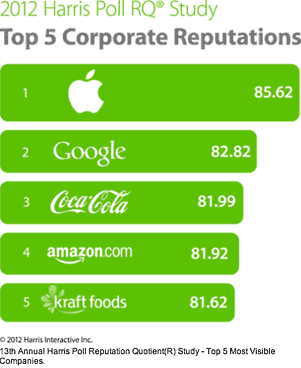 This year's most reputable brand, Apple, benefits
greatly from its hybrid status as a technology/consumer product/retail
company, and earns the highest RQ score to secure the top spot in the
ranking. It displaces Google, last year's most reputable corporation,
which now ranks second with an excellent score of 82.82. The Coca-Cola
Company, ranked 15th in 2011, has surged into third place, despite any
meaningful change in its reputation rating. Amazon.com moves up from
eighth to fourth place, and perennial reputation elite, Kraft Foods,
ranked fifth.
This year's most reputable brand, Apple, benefits
greatly from its hybrid status as a technology/consumer product/retail
company, and earns the highest RQ score to secure the top spot in the
ranking. It displaces Google, last year's most reputable corporation,
which now ranks second with an excellent score of 82.82. The Coca-Cola
Company, ranked 15th in 2011, has surged into third place, despite any
meaningful change in its reputation rating. Amazon.com moves up from
eighth to fourth place, and perennial reputation elite, Kraft Foods,
ranked fifth.
"We are seeing the emergence of a group of companies that garner
reputation equity by being positively associated with multiple
industries," says Robert Fronk, executive vice president and Global
Corporate Reputation Practice Lead for Harris Interactive. "Companies
like Apple, Google, and Amazon.com combine innovation and leadership
across multiple business areas, giving them true competitive
advantage."
In terms of year-over-year change, only Toyota, General Motors, BP,
and Apple enjoy significant improvement in their RQ scores, while one
quarter of companies saw drastic declines. Among those with the most
significant declines, five were financial institutions, including the
2010 top scorer, Berkshire Hathaway.
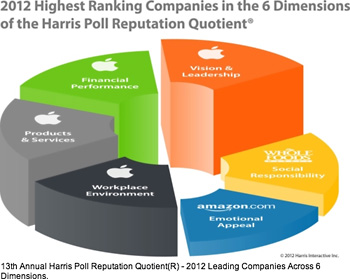 RQ measures six dimensions that comprise reputation and
influence consumer behavior. Apple has the greatest score overall. In
fact, despite today's challenging environment, Apple records the
highest score in the RQ's history, and is top-ranked in four of the six
key dimensions of reputation:
RQ measures six dimensions that comprise reputation and
influence consumer behavior. Apple has the greatest score overall. In
fact, despite today's challenging environment, Apple records the
highest score in the RQ's history, and is top-ranked in four of the six
key dimensions of reputation:
- Social Responsibility: Whole Foods
- Emotional Appeal: Amazon.com
- Financial Performance: Apple
- Products & Services: Apple
- Vision & Leadership: Apple
- Workplace Environment: Apple
Interestingly, Amazon.com, which has no storefront and very limited
human interaction, scores highest in the Emotional Appeal dimension -
this is the core strength of its reputation. In terms of supportive
behavior, customers report considerable confidence in Amazon.com and
several other companies:
- In the future, Americans would "definitely" purchase products &
services from Amazon.com (71%), Kraft Foods (70%), and the Coca-Cola
Company (64%).
- Americans would "definitely" recommend to others products &
services from Amazon.com (64%) and Kraft Foods (57%).
- In the future Americans would "definitely" invest in stock from
Amazon.com (34%), Microsoft (23%), and the Coca-Cola Company
(23%).
- Americans would "definitely" recommend to others to invest in stock
from Amazon.com (46%), the Coca-Cola Company (25%), and Microsoft
(24%)
Scores of 80 and Higher Are Rare This Year
Apple earned "the highest RQ score ever achieved
by any company".
An RQ score of 80 or above signifies a company with an "excellent
reputation." Since first measured in 2000, Apple has shown steady
improvement, earning an elite score of 85.62 this year, the highest RQ
score ever achieved by any company in the 13 years of the RQ study.
Reflecting the negative mood of consumers, this year only eight
companies earn such scores. This is a 50% decrease from 2011, when 16
companies earned this privileged status.
"It's quite striking to see such a drop in the number of companies
scoring 80 or above," said Fronk. "Corporations are facing significant
headwinds as they try to win and preserve consumer trust."
Reputation Rehabilitation Happens
Two automotive companies, each managing through unique reputation
rehabilitation processes for different reasons, saw the greatest
increases in their RQ scores this year.
General Motors' reputation has been steadily moving upward for four
consecutive years. Over the course of that time, the RQ study has seen
its reputation rise 13 points and its ranking move up 14 places. This
year General Motors improves in all six RQ dimensions and advances in
the rankings due to dramatically higher perceptions in the Emotional
Appeal and Vision & Leadership dimensions.
After a series of quality and safety issues resulted in a ten-point
drop last year, Toyota rebounds five points, driven by gains in Product
& Service, Vision & Leadership, and Emotional Appeal
dimensions.
In the pharmaceutical space, Johnson & Johnson, plagued by
recall and quality issues, manages to maintain a score over 80, though
it fell from second highest ranked company in 2011 to seventh in 2012.
For the first time in RQ history, Johnson & Johnson did not rank in
first or second place.
Reputation Retrospective Retail and Manufacturing Swap Places
Meanwhile, the sudden appearance of brick-and mortar retailers like
Best Buy, Costco, JCPenney, Kohl's, Walgreen's, and Macy's on the most
visible companies roster contrasts sharply with the absence of iconic
US-based manufacturers, like IBM and Intel Corporation.
A look back at the RQ most visible list from ten years ago also
shows the dramatic change in the American corporate landscape. At that
time, nine industrial manufacturers (excluding automotive) and six
retailers made the list. This year's list contains two companies in the
industrial manufacturing space and is dominated by 14 retail brands,
nearly one-quarter of the total list.
In charting the ten-year trajectory of individual companies, Apple
and Hewlett Packard emerge as starkly different examples of how
reputation management and behavior can impact perception.
Apple's current dominance is built on strong investments in its
brand, predominantly through its products and services. This
one-dimensional approach to building reputation has ultimately yielded
high associations with all six reputational dimensions and ranks it
first in Financial Performance, Products & Services, Vision &
Leadership, and Workplace Environment.
Conversely, Hewlett Packard, which once outranked Apple, has headed
in the reverse direction. Hewlett Packard's slowly eroding reputation
has been injured by negative perceptions on Ethics and Vision &
Leadership dimensions, and its brand is beginning to feel the
damage.
Link: The
Harris Poll Reputation Quotient® (RQ®)
NPD: Apple #1 Brand in 2011
PR: US consumer technology hardware and consumable sales(1)
fell just one half of a percent in 2011 ending the year at nearly $144
billion, according to leading market research company The NPD
Group.
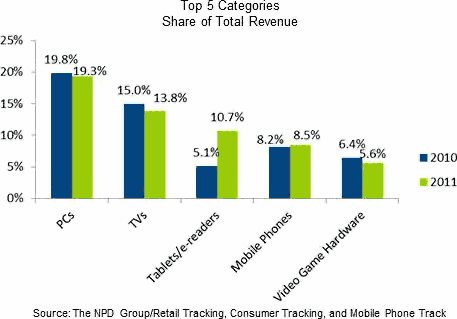
Nearly 60% of all sales in 2011 were driven by the top five
categories; PCs, TVs, tablets/e-readers, mobile phones, and video game
hardware, according to NPD's Retail and Consumer tracking services and
Mobile Phone Track. PCs (notebooks and desktops) generated the most
revenue with nearly $28 billion in sales, accounting for almost 20% of
sales, but that figure was a decline of 3% from 2010. Tablets/e-readers
were the clear winner in 2011, nearly doubling sales to $15 billion in
2011.
"US hardware sales growth is becoming harder and harder to achieve
at the broad industry level," says Stephen Baker, vice president of
industry analysis at NPD. Sales outside of the top five categories fell
by 8% in 2011 as consumers shifted spending from older technologies to
a narrow range of products.
Apple benefited from this shift as it was the leading consumer
electronics brand for the second year in a row. Among the top five
brands Apple was the only one to experience a sales increase, posting a
36% rise over 2010. By the critical fourth quarter Apple accounted for
19% of all sales dollars, almost twice as much as number two
Hewlett-Packard.
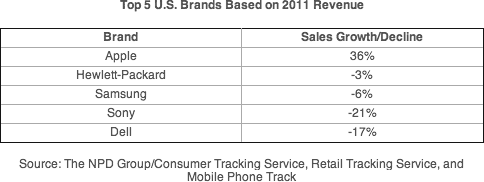
At the retailer level, Best Buy came out on top once again, followed
by Walmart and Apple. Staples and Amazon tied for fourth place to round
out the top five, a repeat of 2010.
Sales through online, direct mail, and TV shopping channels jumped
7% and accounted for 24% of all sales, up from 22% in 2010. Sales
through these non-retail channels captured 25% of industry revenue in
the fourth quarter of 2011.
While in-store sales fell about 2.5% in 2011, the growth in online
volumes for retailers meant that retail name plates still accounted for
well over four of every five dollars spent on CE hardware in the US,
said Baker. Despite their sales strength, retail stores still face
serious challenges in 2012 as volumes in the traditional CE categories,
which once carried these stores, continue to slide. It shouldn't be
forgotten, however, that a large majority of mobile phones and
tablets/e-readers (the two fastest growing CE categories) have mostly
been driven through in-store experiences.
FBI Posts Its Steve Jobs File
The FBI has posted the contents of its 1991 background check file on
Steve Jobs - all 191 pages of it.
The Steven Paul Jobs file was compiled when Jobs was being
considered for appointment to the President's Export Council, on which
Jobs served on the President's Export Council under the George H. W.
Bush administration, and notes that several individuals questioned Mr.
Jobs' honesty, stating that Mr. Jobs will twist the truth and distort
reality in order to achieve his goals. One interviewee characterized
Jobs as an honest and trustworthy individual, but suggested that his
moral character was questionable. Another said she had questions
concerning his ethics and morality. The FBI also notes critically Jobs'
use of marijuana. Another nugget is that Jobs was given Top Secret
security clearance in 1988, later terminated in 1990.
Link: Steven
Paul Jobs
Software
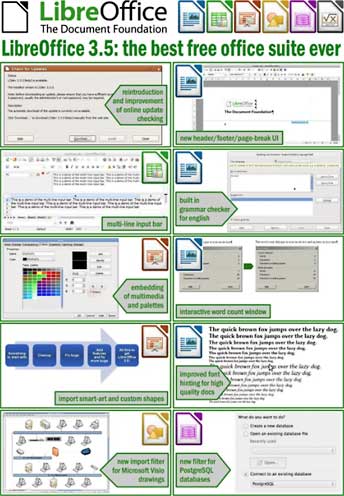 Free LibreOffice 3.5 Office
Suite
Free LibreOffice 3.5 Office
Suite
PR: The Document Foundation announces LibreOffice 3.5, the
third major release of its free office suite alternative to Microsoft
Office, incorporating improvements derived from the development
strategy adopted since September 2010. LibreOffice 3.5 derives from the
combined effort of full time hackers - the largest group of experienced
OOo code developers and volunteer hackers, coordinated by the
LibreOffice Engineering Steering Committee.
The Document Foundation was formed in by former OpenOffice.org
community members who had a philosophical parting of the ways with
Oracle, which acquired the OpenOffice software through its purchase of
Sun Microsystems.
During 16 months, an average of 80 LibreOffice developers each month
have provided a total of over thirty thousand code commits, introducing
new and interesting features such as:
Writer
- a new built-in Grammar
checker for English and several other languages
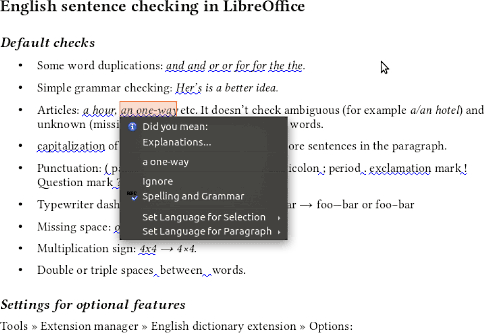 improved typographical
features, for professional looking documents
improved typographical
features, for professional looking documents- an interactive word count window, which updates in real time
- a new header, footer and page break user interface
- Improved font hinting fir high quality docs.
Impress/Draw
- an improved importer of custom shapes and Smart Art from
PPT/PPTX
- a feature for embedding multimedia/colour palettes into ODF
documents
- a new display switch for the presenters console
- new line ends for improved diagrams
- Microsoft Visio import filter

Calc
- support for up to 10,000 sheets
- a new multiline input area
- new Calc functions conforming to the ODF OpenFormula
specifications
- better performances when importing files from other office
suites
- multiple selections in autofilter
- unlimited number of rules for conditional formatting
Base
- a new integrated PostgreSQL native driver
In addition, for the first time in the history of LibreOffice, an
online update checker will be incorporated to inform. users when a new
version of the suite is available.

"We inherited a 15 years old code base, where features were not
implemented and bugs were not solved in order to avoid creating
problems, and this - with time - was the origin of a large technical
debt," says Caoln McNamara, a senior RedHat developer who is one of the
founders and directors of TDF. "We had two options: a conservative
strategy, which would immediately please all users, leaving the code
basically unchanged, and our more aggressive feature development and
code renovation path, which has created some stability problems in the
short term but is rapidly leading to a completely new and substantially
improved free office suite: LibreOffice 3.5, the best free office suite
ever."
"In sixteen months, we have achieved incredible results," comments
Michael Meeks, a SUSE Distinguished Engineer, who is also a founder and
director at TDF - "with nearly three hundred entirely new developers to
the project, attracted by the copyleft license, the lack of copyright
assignment and a welcoming environment. In addition to the visible
features, they've translated tens of thousands of German comments,
removed thousands of unused or obsolete methods sometimes whole
libraries and grown a suite of automated tests. Although we still have
a long way to go, users who have sometimes complained for the stability
of the software, as they were not aware of the technical debt we were
fighting with can now benefit from a substantially cleaner, leaner and
more feature rich LibreOffice 3.5."
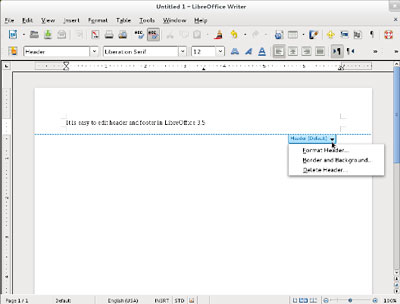
LibreOffice 3.5 is the first release where the contribution of local
communities and associations, such as ALTA in Brazil, has been
acknowledged. In addition, TDF tried to recognize those volunteers who
could easily be identified who put so much into the 3.5 release, with a
hacking or bug hunting hero badge presented the same day of the
announcement. TDF is encouraging the development of a global, open and
diverse ecosystem where companies, associations, local communities and
volunteers share the common objective of developing the best free
office suite ever.
The Document Foundation invites power users to install LibreOffice
3.5, but advises more conservative users to stick with LibreOffice 3.4
branch for now. Corporate users are strongly advised to deploy
LibreOffice with the backing of professional support, from a company
able to assist with migration, end user training, support and
maintenance. The Document Foundation will soon provide a list of
certified organizations providing these professional services.
System Requirements: Macintosh
- Mac OS X 10.4 (Tiger) or higher
- Intel or PowerPC processor
- 512 MB RAM
- Up to 800 MB available hard disk space;
- 1024 x 768 graphic device with 256 colors (higher resolution
recommended).
System Requirements: Windows
- Microsoft Windows 2000 (Service Pack 4 or higher), XP, Vista, or
Windows 7
- Pentium-compatible PC (Pentium III, Athlon or more-recent system
recommended)
- 256 MB RAM (512 MB RAM recommended)
- Up to 1.5 GB available hard disk space
- 1024 x 768 resolution (higher resolution recommended), with at
least 256 colors
- Administrator rights are needed for the installation process
Registration of LibreOffice as default application for Microsoft
Office formats can be forced or suppressed by using the following
command line switches with the installer:
- /msoreg=1 will force registration of LibreOffice as default
application for Microsoft Office formats
- /msoreg=0 will suppress registration of LibreOffice as default
application for Microsoft Office formats
If you perform an administrative installation using setup /a, you
need to make sure that the file mmsvc90.dll is installed on the system.
This file is required for LibreOffice to start after an administrative
installation: http://bit.ly/iNVVTo
Link: LibreOffice
Acorn Image Editor
PR: Everyone needs to edit images at some point, but not
everyone has the time to learn super pricey wizbang image editing
programs. Acorn is a user-friendly image editor that allows you to add
text and shapes to your digital pictures, combine images together to
create your own, work with layers to touch up your favorites or make
something new from scratch.

Acorn Features
- Layer Styles - Apply nondestructive effects to your layers. Try
things out knowing you can always change your mind later on. Multistop
Live
- Gradients - Are two color gradients not enough for you? With
Acorn's multistop gradients, you have infinite rainbows at your
fingertips.
- Rotating Text and Shapes - Ask and you shall receive. Turn your
text and shapes upside down and every which way. You've got it in Acorn
3.
- Quickmask - Make your selections like a pro. Quickmask will allow
you to zoom in and edit your selections like never before.
- Instant Alpha - Remove backgrounds and other unwanted pixels from
your image with a flick of the wrist.
- New Filters - Inner shadow, bevel, circles and lines, we've got
some great new filters in Acorn you're sure to enjoy.
- Vector Chops - In addition to being able to rotate your shapes, you
can now convert text to Bezier paths, add and subtract points, and have
your edges snap to pixel boundaries.

- PSD Import and Export - Improved support for loading PSD images,
and for exporting your images as layered Photoshop files.
- Web Export - Export your images as Optimized PNGs, JPEG, JPEG 2000,
GIF, and even Google's WebP format.
- Acornss2.jpg
- Create Custom Brushes - Use Acorn's built in brush designer to
create new brushes or alter existing ones. Test your strokes out and
watch them instantly update as you change settings.
- Vector Tools - Add ovals, lines, rectangles, or even custom Bezier
paths. Pixels and vectors- two great tastes that taste great
together
- Scriptable and Automatable - You can script Acorn using
AppleScript, Automator, or even JavaScript.
- Filters Filters Filters! - Combine filters together in endless
combinations and customize your own presets.
- Screenshots - Acorn can create layered screenshots of every window
you have open on your computer.
- Selections - Create different shaped selections, invert, feather,
or add a corner radius. Or, if you're looking to quickly select an
entire color, try using the Magic Wand.
- Layer Masks - Use layer masks in your image to block out unwanted
areas of your image or to expose layers below.

New in Acorn 3.2.1:
- New AppleScript property on bitmap layers to get and set the
origin.
- You can now delete a point on a Bezier curve by selecting it and
pressing the delete button.
System Requirements: Mac OS X 10.6+, works great on 10.7 Lion
Link: Acorn
Photo Editing Redesigned with CameraBag 2
PR: Nevercenter has released CameraBag 2 for Mac and PC, a
desktop photo app with a new approach to photos. Redesigned from the
ground up, CameraBag 2's new Analog Engine pairs a full suite of
photographic tools with the high quality filters and vintage
simulations the series is already known for. CameraBag 2's key
innovation is a straightforward approach to layering, rearranging, and
capacity to endlessly tweak all of these effects in realtime. The 100+
fully-adjustable filters and 25+ professional controls CameraBag 2
ships with are only the beginning, forming the palette from which users
create their own styles.
You can watch CameraBag in action at http://www.nevercenter.com/cb2trailer
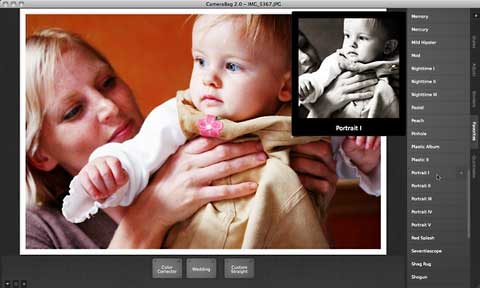
"The most common feedback we got from previous versions was that the
user wanted greater control, without sacrificing CameraBag's
straightforward, accessible nature," says Tom Plewe, Nevercenter's
president. "We came up with a simple tile-based system which presents
all the additional control from the new Analog Engine in a quick,
intuitive way. Then we added fullscreen Quicklooks and instant previews
to emphasize a visual decision-making process. Instead of starting from
scratch with a photo, you can compare a lot of great options, choose
the very best one, and then start tweaking. And you never have to do
the same work twice; once you create a new look or workflow, you just
add it to the menu for next time."
CameraBag was initially released as an iPhone app, climbing as high
as #2 across all paid apps. The first version for Mac and PC CameraBag
Desktop soon followed, proving that the concept scaled beautifully to
high res. photos. CameraBag 2 for Mac and PC is a major upgrade from
both CameraBag iPhone and CameraBag Desktop, rebuilt from the ground up
specifically for desktop computers, and now including a full suite of
photo tools, a whole new interface for finding and creating filters,
nearly 10 times as many built-in looks, and a rewritten engine under
the hood, while maintaining the intuitiveness and approachable feel of
the original app.
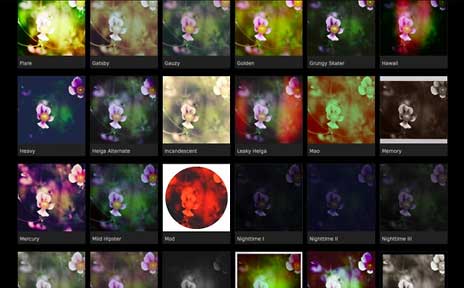
Key CameraBag 2 Features:
- Choose from 100+ built-in styles and filters, or create and share
your own. Filters are easy to export as files to share online. Just
drag and drop a filter file to apply it in CameraBag. Once applied, its
tiles are fully editable.
- Full suite of 25+ manual photographic tools including advanced
curve editors.
- New interface.
- State-of-the-art image processing via the all-new Analog
Engine.
- Add any look you create to the toolset as a fully-adjustable
filter. There are actually many ways to adjust the color of an image,
each with different and useful results, but most image editors force
you to use just one. CameraBag includes many and puts them
side-by-side, including Tint, Color Balance, Colorize, Color Filter,
and Dye. The Color Corrector tool offers targeted color adjustment, a
brand new approach to precise color corrections and modifications. It's
curve-based, so you can target different brightness ranges using all of
our built-in color adjustments.
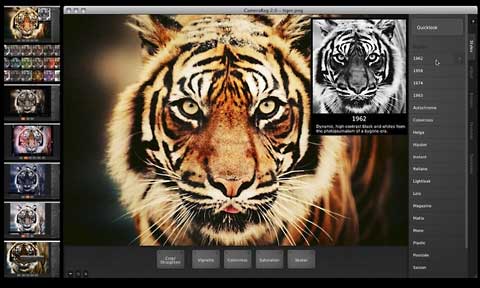
- 32-bits-per-component color depth. CameraBag always works in
32-bits-per-component color depth. This is higher than the default in
Photoshop, for example, and matches the highest precision you can work
with in Photoshop.
- Nondestructive editing (active history).
- Easy layering of styles and adjustments.
- Quicklooks and hover previews for visual decision-making. There are
three ways to browse possible looks for your photo in CameraBag: you
can use the fullscreen Quicklooks, mouse over each filter in the side
panel to get a hover preview, or you can use the up and down arrow keys
on your keyboard to view each filter in the main window. Each is best
in different situations. You can also get inspiration when you don't
know what look you want by pressing the spacebar, which calls the
Random Remixed Filter command from the Edit menu. This will choose a
random filter from the built-in styles or from your saved favorites and
randomly set the Remix value for any tile that has a Remix slider. Keep
pressing it until you find something you like.
- The Remix slider, which smoothly transitions between open-ended
variations.
- Large, precise controls. The sliders in CameraBag are big, but it's
not just for style: big controls give you precision. The developers
have carefully thought out what each slider's range should be, and what
should happen at the end of each slider's range. It can be frustrating
in some photo editors when adjusting exposure, for example, and the
software doesn't let you make your photo as dark or as light as you
want it.
- Arrow key navigation makes it easy to quickly view lots of photos
with different filters. Use left and right to go between files, and up
and down to switch filters.
- Laptop-friendly design.
- Batch saving.
- RAW format and metadata support.
With CameraBag 2, you don't have to know what look you want to get
started. CameraBag 2 lets you see all the possibilities at once:
old-school instant film or modern high-contrast portrait, subtle color
adjustment or complete artistic overhaul. Choose from side-by-side
comparisons with the fullscreen Quicklooks, or get large, instant
previews on mouse-over; the emphasis is on creative exploration. Once
you've chosen a filter, its components are all in the tray to tweak and
adjust nondestructively with large, interactive sliders. The Remix
slider in particular brings back the "happy accidents" of analog film,
smoothly transitioning between infinite natural variations for each
style.
The new CameraBag features a full suite of photographic tools, from
simple exposure and cropping to advanced vignetting, color correction,
and curves. The built-in styles also now have full control over their
strength and variation. Since every adjustment appears as a tile in the
tray, it's easy to see everything affecting the image at once, and
rearrange tiles or edit amounts without compromising image quality.
Adjustments and styles can be freely layered to create new looks, which
can be saved right into the interface as new filters. Whenever a filter
is loaded, the user once again has full control over all of its
tiles.
The Analog Engine
At CameraBag 2's core is the brand new Analog Engine: high-fidelity,
32 bits-per-channel, nondestructive, multithreaded image processing.
Fast and smooth, CameraBag 2 is claimed to match the power of
high-priced software, yet it's light on its feet and starts up
instantly. Its old-school looks are particularly high tech: recreating
the natural blemishes and random variations of the analog world is one
of the hardest digital challenges, and that's where the developers have
devoted much of their research. Even the most heavily-modified photos
retain smooth, film-like colors (especially with the extra color
information in RAW files).
OS X Requirements:
- Intel-based Mac with OS X 10.5 or higher.
- 70 MB hard drive space.
- 1 GB RAM.
Windows Requirements:
- Any Windows OS newer than (or including) Windows XP Service Pack
3.
- 70 MB hard drive space.
- 1 GB RAM.
Import formats
- JPG, PNG, TIFF, most RAW formats.
- With RAW images, CameraBag uses the extra data while editing, then
exports to JPG, PNG, or TIFF.
- Windows users may need to install a codec from the camera's
manufacturer (or the Microsoft Camera Codec Pack) to open RAW
files.
Export formats
- JPG, PNG, TIFF, including metadata.
CameraBag 2 is available now for Mac and PC. A single cross-platform
license is available for $29 (launch sale price: $24), and a Mac-only
version is available via the Mac App Store for $24 (launch sale price:
$19). A free, fully-functional 30-day demo is included in the download
from www.nevercenter.com, where more info, tutorials, and videos can
also be found.
Link: CameraBag 2 (App
Store link)
Free G_RoadTester Vehicle Dynometer Simulation
with Road-test Features
PR: G_RoadTester is a professional high speed automotive
vehicle dynometer simulation including road-test features. This program
is a powerful assistant to have before and during engine tuning and
modification. It gives instant confirmation of accurate results. It
also has a professional and simple user interface so that anyone can
set it up in a few minutes. It comes with sample database examples to
get you started.
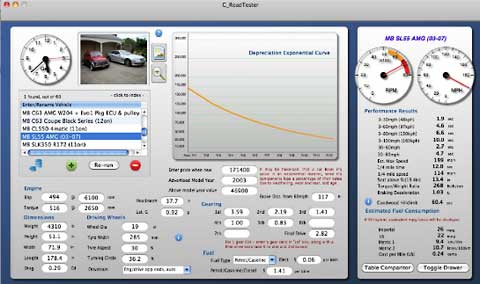
A new and improved version has been now been made available,
incorporating many new features, including revised interfaces, updated
easier to use styles, additional results, and recalibration of many of
the formulas/equations to further refine accuracy.
Due to a change to a more efficient database, data used in the
previous application, is not compatible with this new app., so a new
sample database of 60 vehicles is included in the app. bundle. It is
also capable of calculating equivalent mpg for electric vehicles and
hybrids, including costs per mile.
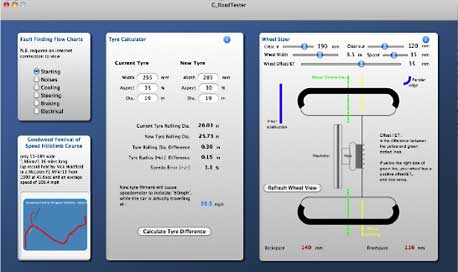
Features
- Dual Core, 10.6 +, 64-bit Only
- Has an ergonomic interface that is easy and simple to use.
- Fast visual results.
- Includes a free sample database of around 60 cars. Don't forget to
backup old data (if any), before installation of new data.
New in version 6.5:
- Added vehicle photo and rtfd editor tabs, to display your vehicle
views and notes.
- Also refinements added, such as an automatic theoretical
computation of imperial miles per gallon, for each vehicle, including
EVs.
- Can run a lap simulation.
- Tyre/Wheel Calculator with visual sizer.
System requirements:
Freeware
Link: G_RoadTester
Desktop Mac
Deals
Low End Mac updates the following price trackers monthly:
For deals on current and discontinued 'Books, see our 13" MacBook and MacBook Pro,
MacBook Air, 13" MacBook Pro, 15" MacBook Pro, 17" MacBook Pro, 12" PowerBook G4, 15" PowerBook G4, 17" PowerBook G4, titanium PowerBook G4,
iBook G4, PowerBook G3, and iBook G3 deals.
We also track iPad,
iPhone, iPod touch, iPod classic, iPod nano, and iPod shuffle deals.


 PR: Apple on Thursday released a developer preview of
PR: Apple on Thursday released a developer preview of
 Mountain Lion
brings popular apps and features from iPad to the Mac and accelerates
the pace of OS X innovation - introducing Messages, Notes, Reminders,
and Game Center to the Mac, as well as Notification Center, Share
Sheets, Twitter integration, and AirPlay Mirroring. Mountain Lion is
the first OS X release built with iCloud in mind for easy setup and
integration with apps.
Mountain Lion
brings popular apps and features from iPad to the Mac and accelerates
the pace of OS X innovation - introducing Messages, Notes, Reminders,
and Game Center to the Mac, as well as Notification Center, Share
Sheets, Twitter integration, and AirPlay Mirroring. Mountain Lion is
the first OS X release built with iCloud in mind for easy setup and
integration with apps. The developer preview of Mountain
Lion also introduces Gatekeeper, a new (Apple says "revolutionary")
security feature to helps keep you safe from malicious software by
giving users complete control over what apps are installed on your
Mac.
The developer preview of Mountain
Lion also introduces Gatekeeper, a new (Apple says "revolutionary")
security feature to helps keep you safe from malicious software by
giving users complete control over what apps are installed on your
Mac. "The Mac is on a roll, growing faster
than the PC for 23 straight quarters, and with Mountain Lion things get
even better," commented Philip Schiller, Apple's senior vice president
of Worldwide Marketing. "The developer preview of Mountain Lion comes
just seven months after the incredibly successful release of Lion and
sets a rapid pace of development for the world's most advanced personal
computer operating system."
"The Mac is on a roll, growing faster
than the PC for 23 straight quarters, and with Mountain Lion things get
even better," commented Philip Schiller, Apple's senior vice president
of Worldwide Marketing. "The developer preview of Mountain Lion comes
just seven months after the incredibly successful release of Lion and
sets a rapid pace of development for the world's most advanced personal
computer operating system." The developer
preview of Mountain Lion features the all new Messages app, which
replaces iChat and allows you to send unlimited messages, high-quality
photos, and videos directly from your Mac to another Mac or iOS device.
Messages will continue to support AIM, Jabber, Yahoo! Messenger, and
Google Talk. Starting today, Lion users can download a
The developer
preview of Mountain Lion features the all new Messages app, which
replaces iChat and allows you to send unlimited messages, high-quality
photos, and videos directly from your Mac to another Mac or iOS device.
Messages will continue to support AIM, Jabber, Yahoo! Messenger, and
Google Talk. Starting today, Lion users can download a  The final version will be available
with Mountain Lion. Reminders and Notes help you create and track your
to-dos across all your devices. Game Center lets you personalize your
Mac gaming experience, find new games, and challenge friends to play
live multiplayer games, whether they're on a Mac, iPhone, iPad, or iPod
touch.
The final version will be available
with Mountain Lion. Reminders and Notes help you create and track your
to-dos across all your devices. Game Center lets you personalize your
Mac gaming experience, find new games, and challenge friends to play
live multiplayer games, whether they're on a Mac, iPhone, iPad, or iPod
touch.
 Mountain Lion presents
notifications in an elegant new way, and Notification Center provides
easy access to alerts from Mail, Calendar, Messages, Reminders, system
updates, and third party apps. Systemwide Share Sheets make it easy to
share links, photos, and videos directly from Apple and third party
apps.
Mountain Lion presents
notifications in an elegant new way, and Notification Center provides
easy access to alerts from Mail, Calendar, Messages, Reminders, system
updates, and third party apps. Systemwide Share Sheets make it easy to
share links, photos, and videos directly from Apple and third party
apps.
 Twitter is
integrated throughout Mountain Lion so you can sign on once and tweet
directly from Safari, Quick Look, Photo Booth, Preview, and third party
apps. Mountain Lion also introduces AirPlay Mirroring, an easy way to
wirelessly send a secure 720p video stream of what's on your Mac to an
HDTV using
Twitter is
integrated throughout Mountain Lion so you can sign on once and tweet
directly from Safari, Quick Look, Photo Booth, Preview, and third party
apps. Mountain Lion also introduces AirPlay Mirroring, an easy way to
wirelessly send a secure 720p video stream of what's on your Mac to an
HDTV using  The
new Gatekeeper security feature gives you control over which apps can
be downloaded and installed on your Mac. You can choose to install apps
from any source, just as you do on a Mac today, or you can use the
safer default setting to install apps from the Mac App Store, along
with apps from developers that have a unique Developer ID from Apple.
For maximum security, you can set Gatekeeper to only allow apps from
the Mac App Store to be downloaded and installed.
The
new Gatekeeper security feature gives you control over which apps can
be downloaded and installed on your Mac. You can choose to install apps
from any source, just as you do on a Mac today, or you can use the
safer default setting to install apps from the Mac App Store, along
with apps from developers that have a unique Developer ID from Apple.
For maximum security, you can set Gatekeeper to only allow apps from
the Mac App Store to be downloaded and installed. Manock, who these days lives in Burlington,
Vermont, was 33 back in 1977 when he was one of Apple's five employees,
hired by Steve Jobs as a consultant to design the Apple II. Routly
reports that Manock gets credit for almost everything but the circuit
board and the logic (which was engineered by Jobs partner and Apple
cofounder Steve Wozniak), including the structure, the outside
aesthetics, and the color beige (Pantone 453, the color of the
deep-space universe, Manock says), and was part of the original team of
a half-dozen workers who designed the original Mac.
Manock, who these days lives in Burlington,
Vermont, was 33 back in 1977 when he was one of Apple's five employees,
hired by Steve Jobs as a consultant to design the Apple II. Routly
reports that Manock gets credit for almost everything but the circuit
board and the logic (which was engineered by Jobs partner and Apple
cofounder Steve Wozniak), including the structure, the outside
aesthetics, and the color beige (Pantone 453, the color of the
deep-space universe, Manock says), and was part of the original team of
a half-dozen workers who designed the original Mac. This year's most reputable brand, Apple, benefits
greatly from its hybrid status as a technology/consumer product/retail
company, and earns the highest RQ score to secure the top spot in the
ranking. It displaces Google, last year's most reputable corporation,
which now ranks second with an excellent score of 82.82. The Coca-Cola
Company, ranked 15th in 2011, has surged into third place, despite any
meaningful change in its reputation rating. Amazon.com moves up from
eighth to fourth place, and perennial reputation elite, Kraft Foods,
ranked fifth.
This year's most reputable brand, Apple, benefits
greatly from its hybrid status as a technology/consumer product/retail
company, and earns the highest RQ score to secure the top spot in the
ranking. It displaces Google, last year's most reputable corporation,
which now ranks second with an excellent score of 82.82. The Coca-Cola
Company, ranked 15th in 2011, has surged into third place, despite any
meaningful change in its reputation rating. Amazon.com moves up from
eighth to fourth place, and perennial reputation elite, Kraft Foods,
ranked fifth. RQ measures six dimensions that comprise reputation and
influence consumer behavior. Apple has the greatest score overall. In
fact, despite today's challenging environment, Apple records the
highest score in the RQ's history, and is top-ranked in four of the six
key dimensions of reputation:
RQ measures six dimensions that comprise reputation and
influence consumer behavior. Apple has the greatest score overall. In
fact, despite today's challenging environment, Apple records the
highest score in the RQ's history, and is top-ranked in four of the six
key dimensions of reputation:


 improved typographical
features, for professional looking documents
improved typographical
features, for professional looking documents











